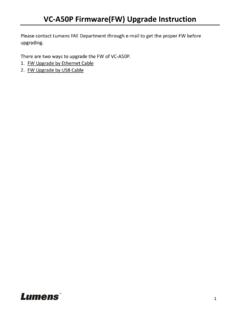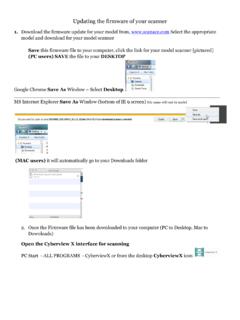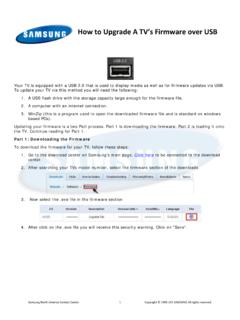Transcription of The BlueNRG-1, BlueNRG-2 BLE OTA (over-the-air) firmware ...
1 IntroductionThis application note describes the BlueNRG-1, BlueNRG-2 over-the-air (OTA) firmware upgrade procedures running on top ofBluetooth low energy (BLE) stack provided with the BlueNRG-1, BlueNRG-2 systems-on-chip. First of all, it starts with someconcepts related to "over-the-air" firmware upgrading process and then guides the user through all steps required to run someOTA firmware upgrading OTA firmware upgrade is supported on the following devices and BLE stack versions:Table 1. BLE OTA firmware upgradeBLE deviceBLE stack versionOTA FW upgrade (1) or laterYes (2) , 1. It is provided on the BlueNRG-1 DK SW package supporting the BLE stack is supported with the BLE stack modular approach, basic configuration(BLE_STACK_CONFIGURATION=BL E_STACK_BASIC_CONFIGURATION): No controller privacy No LE secure connections No master/central role No data length extension Note:The document content is valid both for the BlueNRG-1 and the BlueNRG-2 device.
2 Any reference to theBlueNRG-1 device is also valid for the BlueNRG-2 device. Any specific difference is highlighted whenever it BlueNRG-1, BlueNRG-2 BLE OTA (over-the-air) firmware upgradeAN4869 Application noteAN4869 - Rev 4 - September 2018 For further information contact your local STMicroelectronics sales concept of "over-the-air" firmware upgrade "Over-the-air" (OTA) firmware upgrade is a protocol that allows a Bluetooth low energy slave device to receive afirmware image over-the-air from a Bluetooth low energy master device and write it into Flash memory. To putthings in the right context for Bluetooth low energy technology, OTA firmware upgrade framework defines aservice exposing its own characteristics, which can coexist with other services used by any given applicationrunning on the BLE stack.
3 The BLE master is a combined system made of a BlueNRG-1, BlueNRG-2development kit platform connected to a PC through USB. This BlueNRG-1, BlueNRG-2 platform is driven by theBlueNRG GUI. Thanks to this choice, a lot of resources are available from PC, specifically with regards tocompilers for firmware image generation and memory space required to store images before they are deployedover-the-air for firmware 1. BlueNRG-1, BlueNRG-2 OTA master and slave devicesAN4869 The concept of "over-the-air" firmware upgrade AN4869 - Rev 4page 2/262 OTA FW upgrade service descriptionThe OTA FW upgrade service is addressed through the files OTA_btl.[ch] provided within the BlueNRG-1_2 DKSW package (Library\Bluetooth_LE\OTA folder).A short description about the OTA FW upgrade service and its related characteristics follows: Btl OTA service: it is the FW upgrade service aci_gatt_add_service(UUID_TYPE_128, &ota_service_uuid, PRIMARY_SERVICE, 10,&btlServHandle); Btl image characteristic : it contains some information about lower and higher bounds of free memory assuggested by the current application that includes the OTA FW upgrade service aci_gatt_add_char(btlServHandle, UUID_TYPE_128, &ota_char_uuid, 8, CHAR_PROP_READ,ATTR_PERMISSION_NONE, GATT_NOTIFY_READ_REQ_AND_WAIT_FOR_APPL_R ESP,16, 0,&btlImageCharHandle).
4 Btl new image characteristic: it contains the base address and the size of the image that the master pretendsto send over-the-air and the notification range requested to the slave for sending acks during OTA FWtransfers aci_gatt_add_char(btlServHandle, UUID_TYPE_128, &ota_char_uuid, 9, CHAR_PROP_READ|CHAR_PROP_WRITE|CHAR_PROP _WRITE_WITHOUT_RESP, ATTR_PERMISSION_NONE,GATT_NOTIFY_READ_RE Q_AND_WAIT_FOR_APPL_RESP |GATT_NOTIFY_ATTRIBUTE_WRITE,16, 0, &btlNewImageCharHandle); Btl new image content characteristic: it contains a 16-byte block of firmware image data sent by the master(through a characteristic write command) along with some control information such as: block sequencenumber (2 bytes) and checksum for integrity check 1 byte) aci_gatt_add_char(btlServHandle, UUID_TYPE_128, &ota_char_uuid, 20, CHAR_PROP_READ|CHAR_PROP_WRITE|CHAR_PROP _WRITE_WITHOUT_RESP, ATTR_PERMISSION_NONE,GATT_NOTIFY_READ_RE Q_AND_WAIT_FOR_APPL_RESP |GATT_NOTIFY_ATTRIBUTE_WRITE,16, 0, &btlNewImageTUContentCharHandle).
5 Btl expected image sequence number characteristic, through which the slave device notifies the masterabout the next block it expects and error conditions aci_gatt_add_char(btlServHandle, UUID_TYPE_128, &ota_char_uuid, 4, CHAR_PROP_NOTIFY|CHAR_PROP_READ, ATTR_PERMISSION_NONE,GATT_NOTIFY_READ_RE Q_AND_WAIT_FOR_APPL_RESP, 16, 0,&btlExpectedImageTUSeqNumberCharHandle );Note:OTA FW upgrade service and characteristics proprietary UUIDs (128 bits) are defined within the file firmware upgrade transactionsIn this section the steps about OTA firmware upgrade are dealt the master and slave device running the OTA FW upgrade service are set, a discovery procedureneeds to be fulfilled in order to allow the two devices to be connected. Discovery is achieved listening toadvertisements coming from the devices within the radio range (active scan) and selecting the onescontaining the OTA FW upgrade service UUID (128 bits) within the scan Further, the name of the selected device is read from the advertising message to be utilized by master inorder to enhance the slave identification After connection, the master sends ACI_GATT_DISC_CHAR_BY_UUID commands in order to read all OTAFW upgrade characteristic The master reads the Btl image characteristic through a ACI_GATT_READ_CHAR_VALUE command to beaware of free space on the target slave device Flash Based on the information carried out at the previous step, the master selects a proper image to send over-the-air.
6 The candidate image (placing somewhere on the master as *.bin file) has to fit within the target freeFlash FW upgrade service description AN4869 - Rev 4page 3/266. Once the selection is done, the master sends a ACI_GATT_WRITE_CHAR_VALUE in order to write imagebase address, size and notification range into the Btl new image characteristic and reads it back through ACI_GATT_READ_CHAR_VALUE in order to verify The master writes into the Btl expected image sequence number characteristic descriptor to enable slavenotifications for image block sequence numbers and errors. Once the slave receives this command it sendsback a The image transfer begins. The master sends the image in blocks of (N*16) bytes through a sequence of ACI_GATT_WRITE_WITHOUT_RESP commands (one for each (N*16)-bytes block).
7 Each time a newwrite command lands on the target slave it writes the new block of data within the Btl new image contentcharacteristic. Each (N*16)-bytes block comes along with a 2-byte long sequence number and one byte longchecksum field in order to check for the sequencing and message integrity at destination. Every time theslave internal buffer gets filled up by (N*16)-byte blocks, it downloads into Flash memory. Once the slavehas completed to manage the internal buffer of (N*16)-byte blocks, it sends a notification message back tothe master providing the block number of the next expected block. It might notify Flash write errors andFlash verify errors as well on latest blocks, in which case the bootloading session should stop under theassumption that we deal with issues on the destination device = 1 for the BlueNRG-1, BLE stack and BLE stack or later, BlueNRG-2 , BLE stack = ((OTA_ATT_MTU_SIZE - 3 - 4)/16) for the BlueNRG-2 , BLE stack or later with data lengthextension enabled for OTA FW upgrade the BlueNRG-2 , BLE stack or later with data length extension feature (max.)
8 PDU length = 251bytes) and increased ATT_MTU size (> 23 bytes), N is tailored to get an OTA packet size which fits, as muchas possible, within the max. allowed BlueNRG-2 OTA client ATT_MTU size (OTA_ATT_MTU_SIZE). Thisallows the data size to be increased and transferred on each BLE OTA packet at link layer level and the OTAFW upgrade procedure to be speed BLE stack HCI_LE_SET_DATA_LENGTH() and ACI_ATT_EXCHANGE_MTU() APIs are used inorder to set the data length extension feature on both OTA client transmitter and OTA server receiver sides,and agree on the max. supported ATT_MTU OTA FW packet structure used by the ACI_GATT_WRITE_WITHOUT_RESP command is the following:Figure 2. OTA_packet_structure8 (N*16)*8 816 bitsChecksumNeeds ackSequence numberImage dataWhere: Checksum byte is used for packet integrity check Image data bytes contain the (N * 16) bytes of input file to be transferred Needs ack byte indicates when OTA client expects a notification from slave during the OTA FW transfer(1: if notification is expected; 0 if no notification is expected) Sequence number bytes are used to indicate the expected image sequence number value used duringthe OTA FW transfer9.
9 If the number of bytes downloaded successfully on the destination device Flash is equal to the initiallyprovided image size information, the OTA FW upgrade procedure writes a specific application validity tag ona reserved entry of each application interrupt vector table in order to allow the OTA reset manager toproperly identify the address of the new valid The application validity tag stored on the interrupt vector table allows OTA FW upgrade session failures tobe handled by avoiding to jump to a not valid application (the control is always transferred to the last validapplication).AN4869 OTA firmware upgrade transactions AN4869 - Rev 4page 4 OTA service firmware upgrade architectureThe BLE OTA service firmware upgrade architecture includes the following components: Reset manager It should start after resetting and passing control to the latest updated and valid BLE application.
10 Application with BLE OTA service (lower application) It defines the OTA service in order to provide itself the OTA firmware upgrade capability. When running, it allows new application image packets to be got over-the-air and stored in a specificFlash section (higher application storage area). If the OTA FW upgrade process is successfully completed, a SW reset is generated to give control tothe new valid higher application through the reset manager. Application with BLE OTA service (higher application) It also defines the OTA service in order to provide itself the OTA firmware upgrade capability. When running, it allows new application image packets to be got over-the-air and stored in a specificFlash section (lower application storage area).














